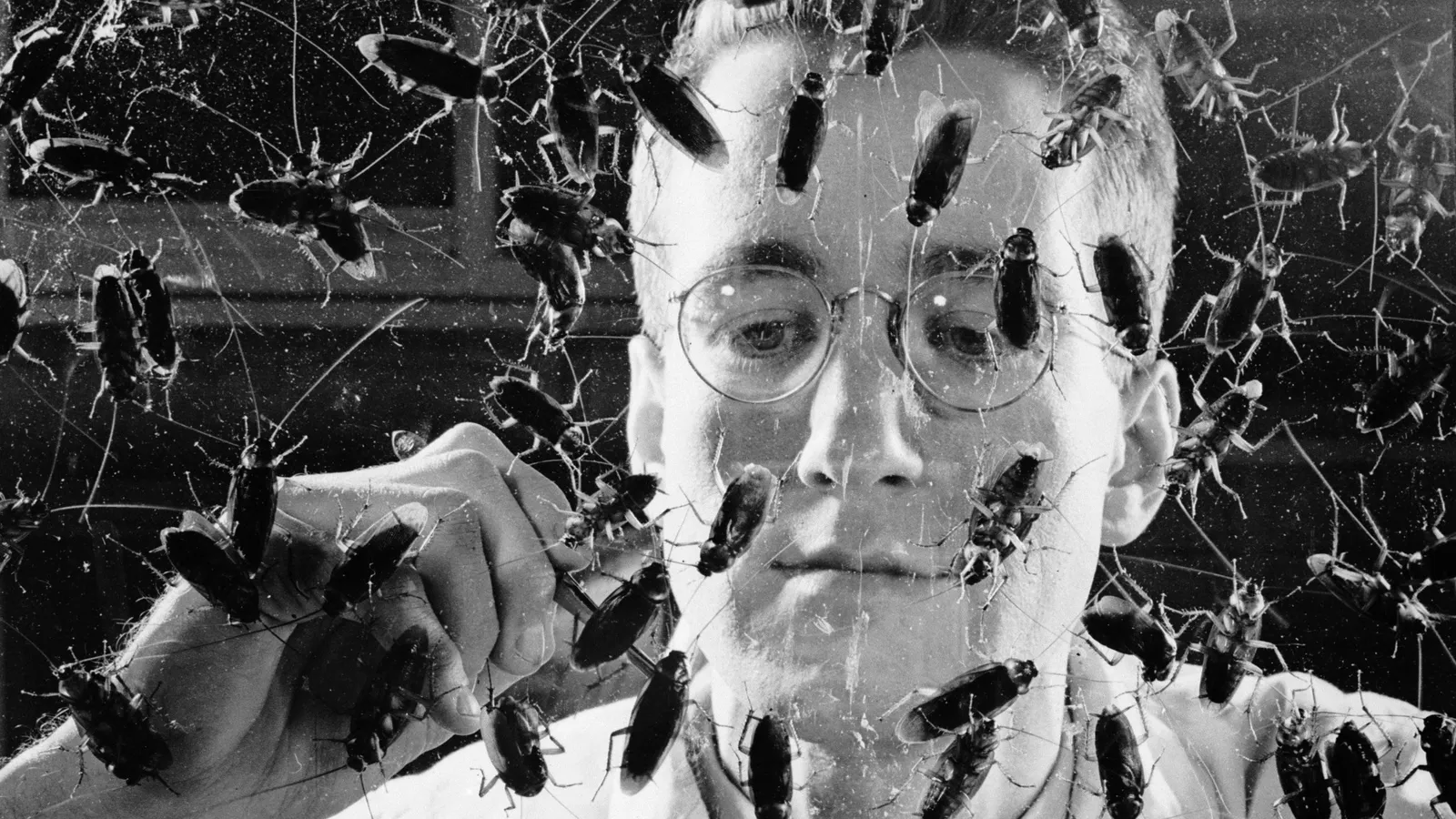
When looking to other creatures for signs of intelligence, insects are rarely the most obvious candidates, but as the historian Thomas Moynihan writes, it wasn't always so. What can the early-20th Century fascination with bug societies tell us about our own?
It is 1919, and a young astronomer turns a street corner in Pasadena, California. Something seemingly humdrum on the ground distracts him. It's an ant heap. Dropping to his knees, peering closer, he has an epiphany – about deep time, our place within it, and humanity's uncertain fate.
The astronomer was Harlow Shapley. He worked nearby at Mount Wilson Observatory: peering into space. With help from colleagues like Henrietta Leavitt, Annie Jump Cannon, and Cecilia Payne-Gaposchkin, Shapley went on to "measure" the Milky Way. Their work revealed that we don't live at our galaxy's centre, and that there are many other galaxies besides.
A lifelong advocate of progressive causes, Shapley also reflected regularly upon humanity's long-term future, alongside the risks jeopardising it. He was among the first to suggest, during a lecture given while World War Two raged, that humanity should learn the lesson from 1918's pandemic and prepare properly for the next one. Instead of battling each other, he prescribed a "design for fighting" the risks facing all of humanity: declaring war on the gamut of evils, from pandemics to poverty, endangering the whole globe. (Only two audience members applauded; it appears we didn't take heed.)
Shapley, also, was obsessed with ants. By night, he mapped the vast cosmos; by day, he studied the smaller-scale universe of ants, publishing pathbreaking papers on his discoveries during his time at Mount Wilson. Megapolises in miniature, easier to study that human societies, Shapley’s hunch was that the antheap could shed light on how life and mind emerged from inert matter as part of "cosmic evolution".
Later, near his life's end, Shapley could mercurially recount many entomological "episodes". The time he abducted ants from Egyptian pyramids, storing one in a friend's watch; the time he pickled one in vodka to the amusement of Soviet colonels; the time he accidentally smoked some, forgetting he had preserved them in his tobacco pouch.
Some colleagues didn't understand the fascination. Connecting big-picture cosmology to humanity's destiny makes sense, sure. But connecting either with bugs seemed oddball. "Shapley's funny", they sighed.
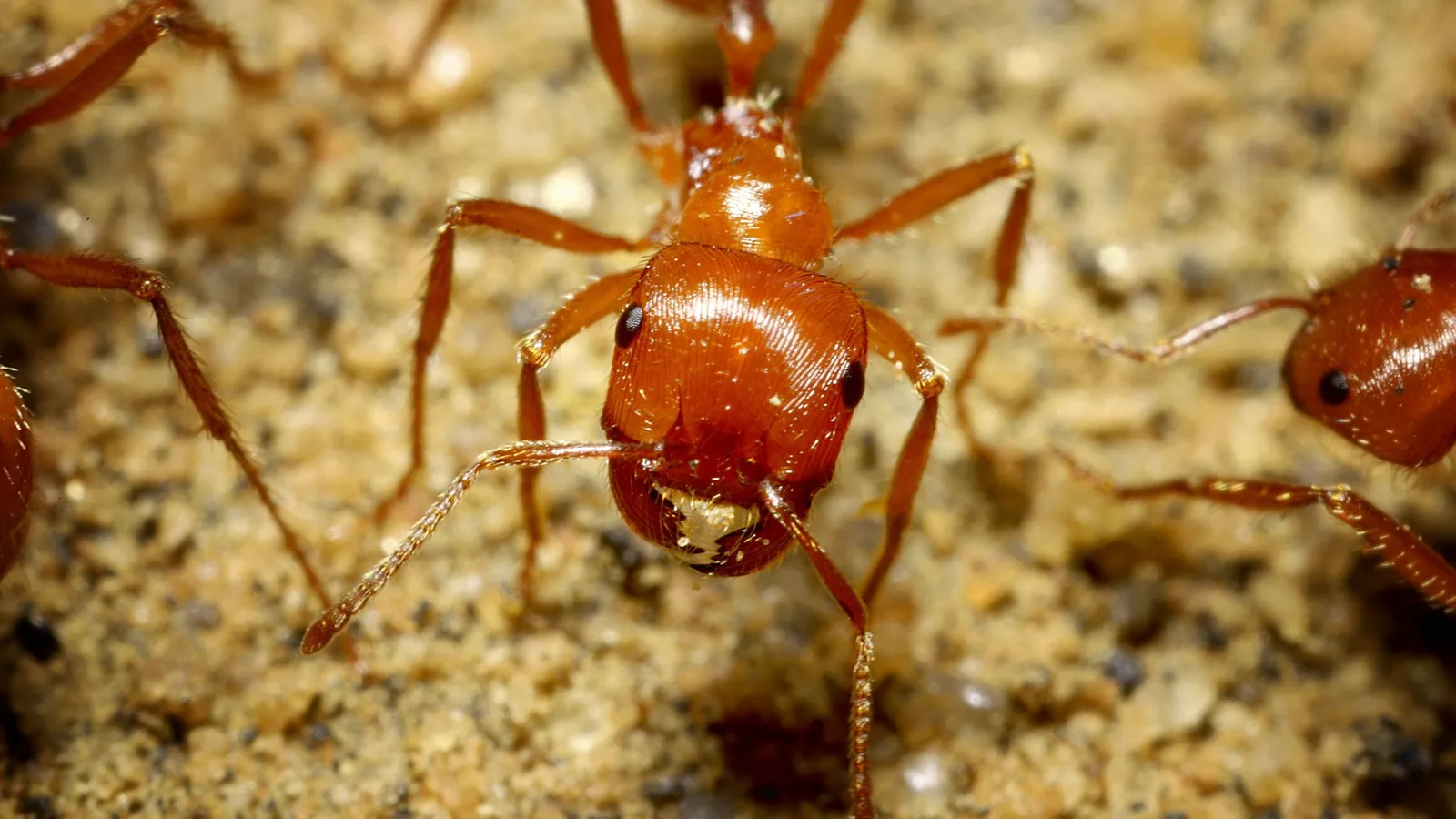
Pogonomyrmex californicus, the ant species witnessed by Shapley in Pasadena (Credit: Getty Images)
But Shapley was not the only ponderer of the interwar period to conscript ants to reflect upon human destiny. Far from it. Shapley's generation had gained renewed respect for the creatures. It had just been discovered that they had developed "civilisation" long before us. Millions of years before, in fact, proving that complex society doesn't have to be vertebrated, because we vertebrates aren't even nearly the first to make the attempt.
This is the story of how discoveries regarding the humble ant influenced our view of humanity's place – and ultimate prospects – within the Universe. And the lessons it holds are just as pertinent in the present day as they were a century ago.
Kneeling in the streetcorner dirt in 1919, Shapley knew he was face-to-face with a "living fossil society". An ancient civilisation, epochs older than our own, and, in silent ways, more experienced. Mapping galaxies may locate humanity in space, Shapley realised, but considering the ant gives us "orientation in time". Human civilisation may seem ancient from the perspective of our fleeting lives, but this is a limited outlook. Here, in the dirt, was a society unfathomably older than our own: revealing we are but newcomers to the game.
Stuck in our own minds, it's difficult to get an outside understanding of human intelligence. But the ingenuity of non-human animals helps us gain perspective. Scientific enquiry has often revealed that other organisms are far smarter than previously assumed. This has allowed people to use them as a kind of mirror, within which to reflect upon our own peculiarities. They are our relatives, yet their relative distance illuminates.
Presently, many are captivated by the intelligence of the octopus, with their adept use of tools and impressive ability to solve puzzles. During the Cold War, it was the linguistic prowess of dolphins. But for Shapley's interwar generation, it was the social insects – ants, bees, wasps, termites.
Of course, invertebrate smarts had long been admired. Back in 1377, Arabic sociologist Ibn Khaldūn reflected that "government" is seemingly unique to humans and bees. Later, Enlightenment entomologists debated whether insects have "souls". By 1879, English eccentric John Lubbock borrowed a microphone from the inventor of the telephone, which he promptly inserted into an antheap to ascertain if its denizens were "talking" to each other at volumes too quiet for human hearing. More enduringly, he explored whether ants communicate with scents. (Lubbock even owned a pet wasp, who earned an obituary in the journal Nature, upon passing away.)
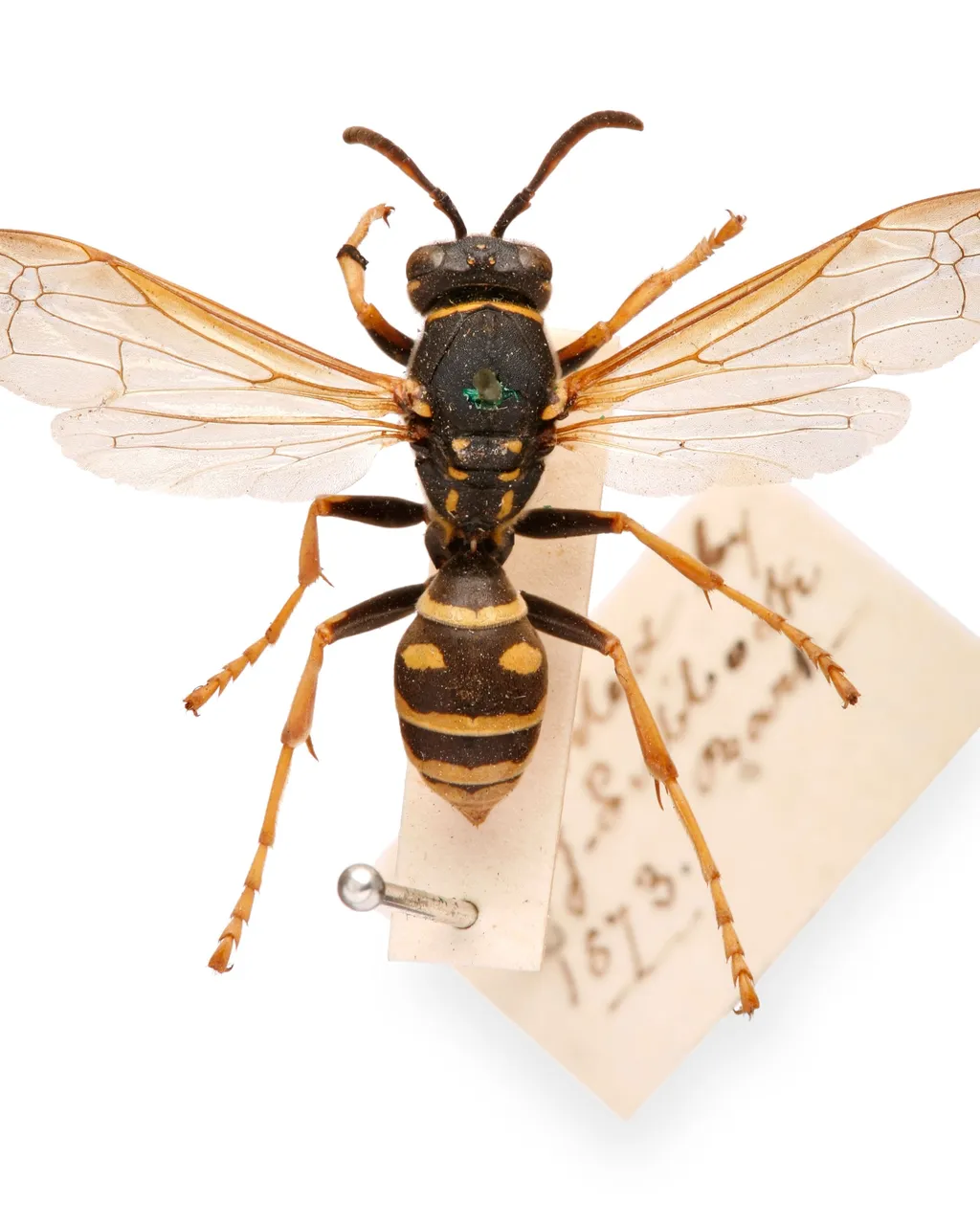
Lubbock's wasp, described by one journalist as "a little gentleman in a brown overcoat, with black and yellow nether garments" (Credit: Alamy)
Few, however, had suggested insects as comparators or superiors of humanity. Homo sapiens was invariably seen as the final and "noblest" result of evolution. Insects, contrastingly, were dismissed as mere beginners: the least developed beasts.
But in the early 1900s there emerged a galvanised sense of just how socially accomplished some bugs are. This was thanks largely to W M Wheeler, who coined the word "superorganism" to describe ant colonies in 1911. For Wheeler, as cells cooperate to become an organism, organisms cooperate to become a superorganism, each producing a whole more potent than its parts.
Entomologists of the 1910s and 1920s marvelled at how ants exercise agriculture and altruism, domesticate other animals – such as aphids and scale insects – provide for posterity, and "urbanise" their environment, with finesse rivalling humans. (We now recognise that ants mitigate epidemics by practising self-isolation and social distancing: a "design for fighting" Shapley might be proud of.) The scientist and feminist Adele Marion Fielde, who invented artificial nests allowing unprecedented intimacy in observing of ant behaviour, marvelled at "the mystery of their civilisation".
It's no coincidence this was the era when people started imagining intelligent aliens as more conspicuously insect-like. Where, today, films likeArrival often portray tentacled aliens, in line with our admiration for octopus smarts, and Cold War attempts to communicate with extraterrestrials were influenced by revelations regarding dolphin language, so were the insectoid moon-dwellers of the period the product of its own fascinations.
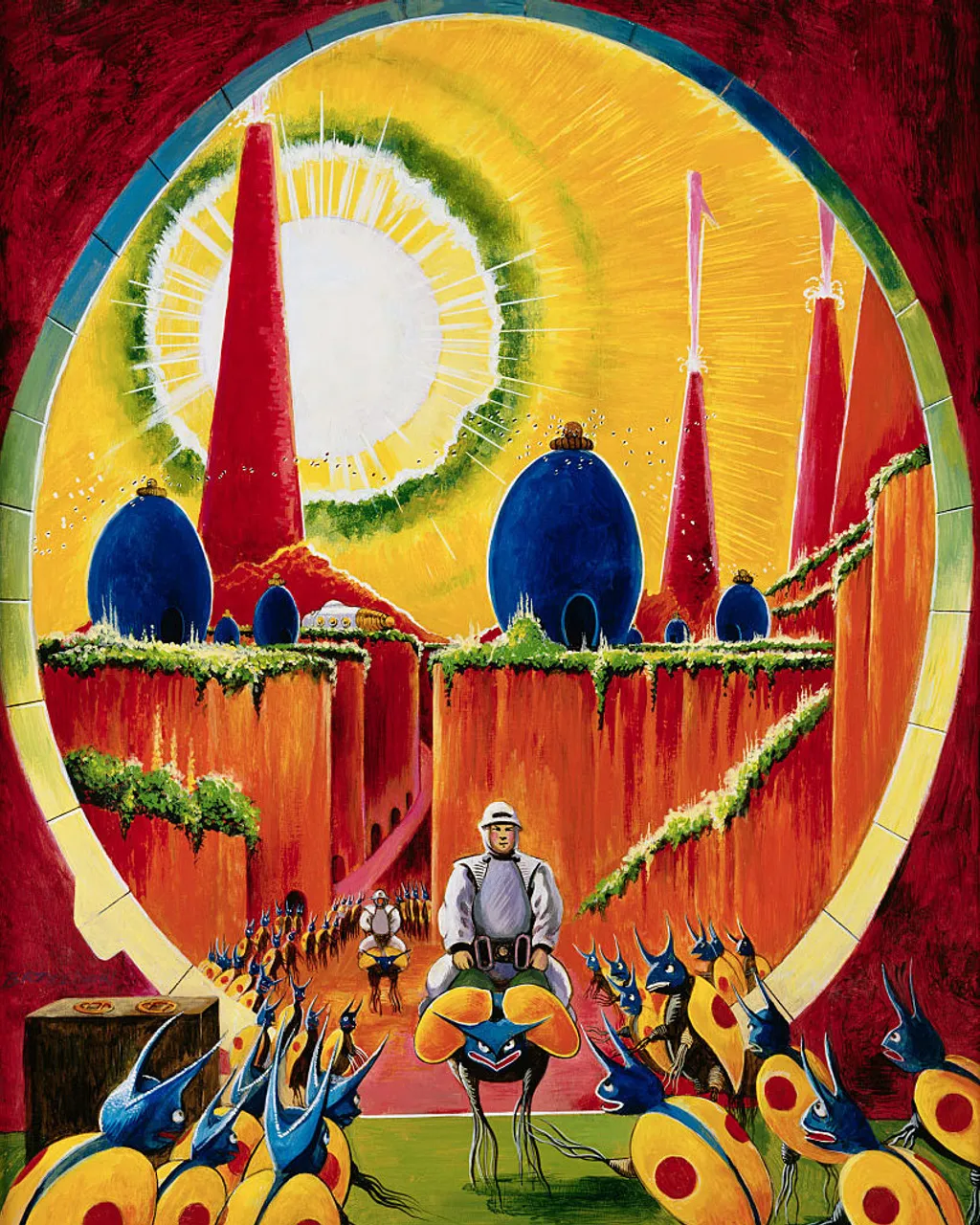
A painting redolent of 20th Century pulp sci-fi, with insects as aliens (Credit: Getty Images)
The question was immediately asked: was this really intelligence? Going back to Ibn Khaldūn, many had previously dismissed the behavioural intricacy of insects as "mere" instinct: rigid, rote, unreasoning; never free nor flexible. However, by the opening of the 1900s, this seemed less clearcut.
It wasn't so much that scientists were claiming the "little winged fellows" were rational like us (as some mocked). It was more that insect societies had achieved so much without anything like our brains. Maybe, then, it wasn't a question of either intelligence or instinct, but of diversifying our definitions. For perhaps the first time, scientists were being led to recognise a very different type of wisdom and mind.
No longer could one so easily assume human rationality was the only viable, nor perhaps even the best, form of problem-solving. Filial insects weren't merely an evolutionary prologue to the "approaching humanity", as poets of the 1800s had previously lyricised: theirs was an entirely different, yet perhaps equally successful, mode of cooperating.
Reversing prior roles, some even imagined we might be "progressing" toward the ant. One biologist claimed that globalisation represents the "birth" of a planet-embracing superorganism: with transnational interchange forming the "blastoderm" of a planetary nervous system; wrought by countless actors cooperating, assimilating organic and inorganic flows into its "omnivorous world-wide plasmodium". The creepier implications weren't missed. Sci-fi authors prophesied that the faceless hive mind gestated by such hyper-coordination would eventually come to dominate Earth, usurping humans from the driving wheel of world history. In pulpy novels, mad scientists set about attempting to facilitate such a transition.
For the era that saw the rise of totalitarianism, such intimations were immediately political. Essayists saw the punishing collectivism of ants as a cautionary fable. Western leaders used the termite as an analogy for Soviet communism. One mystic even bizarrely theorised that ants are remnants of a prehistoric humanoid civilisation: which, pursuing strict conformism, let their autonomy wither, eventually transmogrifying into today's insects. (At the same time, however, some Russian polymaths found poignant foils for social Darwinism in the insects' inspiring altruism.)
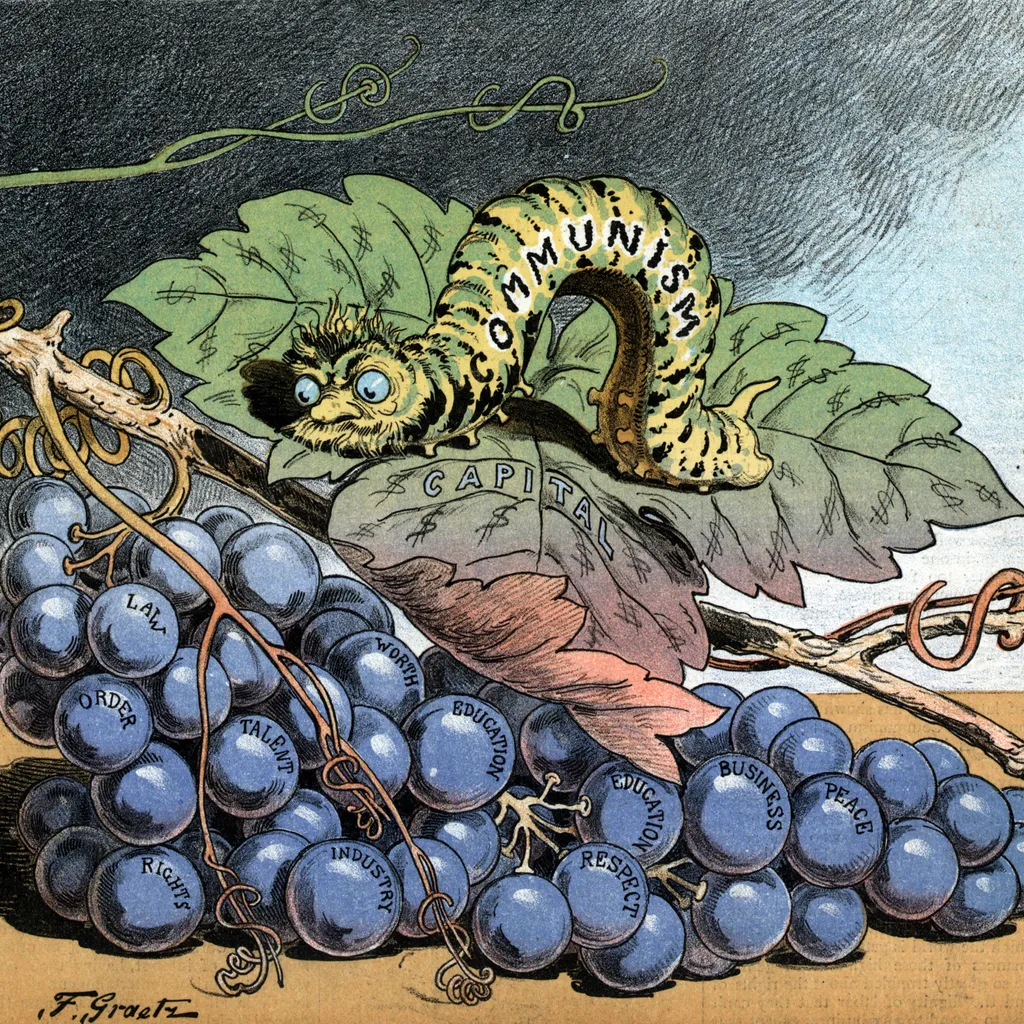
The caterpillar of communism, in an anti-Soviet propaganda cartoon (Credit: Getty Images)
But, below all this, there arrived a lesson even more revelatory. Insects had not only "solved" many of the issues facing social beings: they had done so millions of years ago.
Geologists had, since the mid-1800s, been piecing together a global timescale for life's past, by correlating strata with fossils appearing within them. This enabled comparison of the emergence, and duration, of biological lineages. Experts were quickly marvelling that insects appear to be "far more ancient" than many of life's other branches.
Cockroaches were singled out as particularly venerable, with roach-like fossils replete throughout strata dating from the Carboniferous. Starting some 350 million years ago, this was well before the emergence of dinosaurs, flowering plants, and mammals. One palaeontologist, in 1886, even dubbed the Carboniferous the "Age of Cockroaches". The roach was revealed, therefore, as a "very aristocrat among insects": its "pedigree" notably outstripping many lifeways commonly considered more worthy.
More importantly, it seemed roaches had hardly changed their design across this marathon span. A "true conservative", commentators remarked: today's model proudly inherits a tried-and-tested plan from its great-grandparents and far beyond.
Social insects aren't quite so old. But, where scientists in the 1880s surmised ants had developed "social habits" a modest 5 million years ago, W M Wheeler was demonstrating in the 1910s that they had apparently been cooperating — and had also remained impressively unchanged – for at least"65 million years".
Not only could Homo sapiens no longer assume it was the only civilisation on Earth, but it also couldn't even claim to be the first to attempt it.
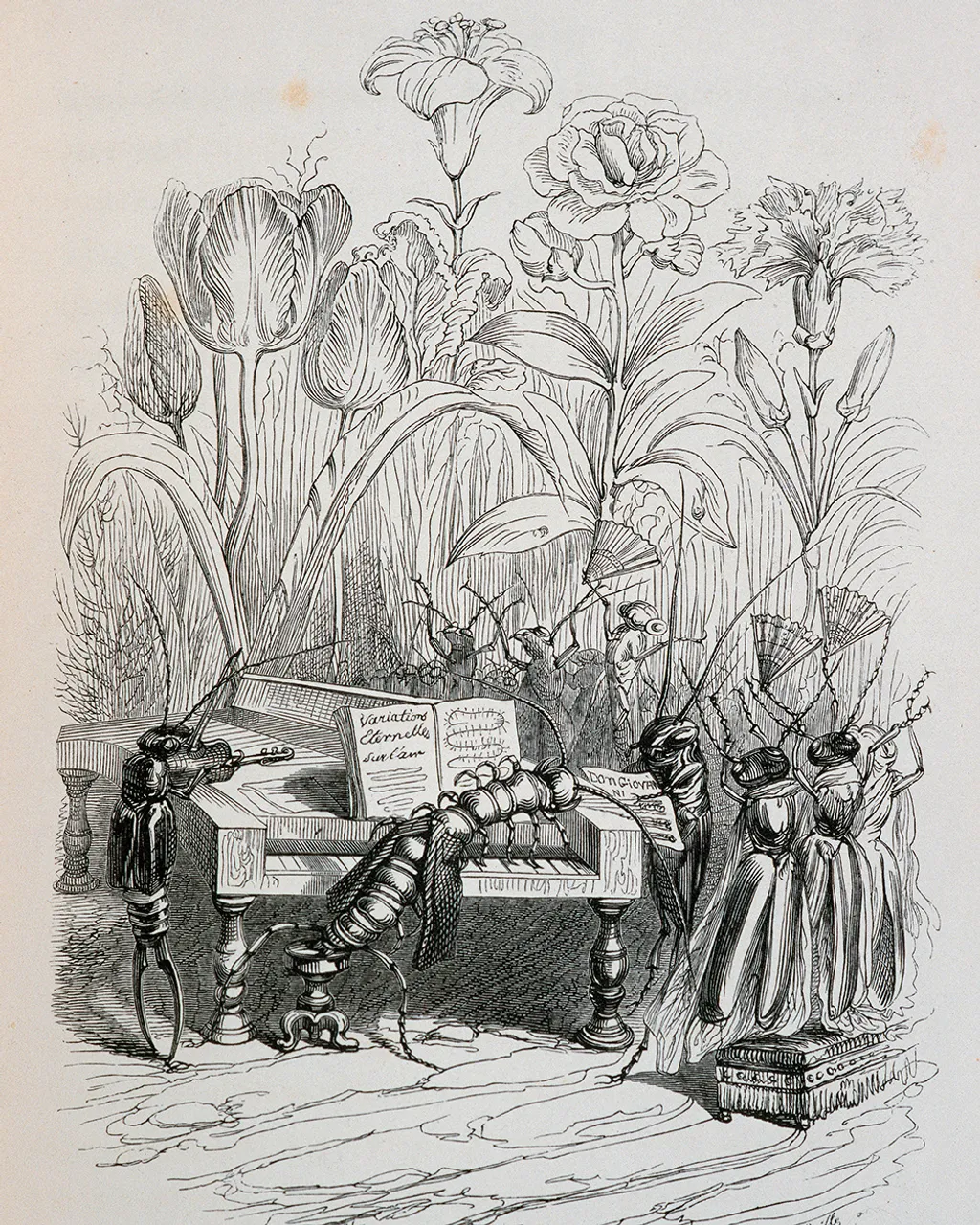
A cartoon from the mid-1800s, using apparently sophisticated insects to satirise French society (Credit: Getty Images)
Intellectuals thus began worrying that we human latecomers, untried and untested in comparison to the well-proven bug, might be "destined to a far shorter use of the Earth": that insects might be around long after we have "joined the dinosaur and the dodo". In 1903, a popular entomology book predicted the last creature on Earth will be a "melancholy bug", basking in the "cherry-red" rays of a "worn-out Sun". Sci-fi authors predicted a post-human world, billions of years in the future, populated exclusively by warring civilisations of giant termites and ants.
Upon further discoveries revealing the sheer ecological success of ants, scientists began proclaiming that this was already the "age of insects". By the 1920s, entomologists often lauded bugs not only as humanity's "chief competitors", but also as life's currently "dominant group".
One journalist put it like this: if you gave a "vote to every creature living", humanity would "not figure in the returns". Even after forming a vertebrate voting bloc, we'd still be "outvoted" by minibeasts in life's parliament.
Some thus called for world history to be again rewritten – not in terms of "economics", emperors, or "sea power" – but "in terms of insects". Others pronounced it had been "egotistical" for geologists to ever suggest ours was the planet's "human era": the "old anthropocentric school is, indeed, dead".
No longer did humanity so comfortably seem the sole protagonist and climax of Earth history, the most inevitable answer to life's game. Indeed, prior generations had often assumed that something humanoid was life's inevitable outcome throughout the cosmos. But here, on our planet, had been revealed another lifeway, eminently civilised, yet strangely alien.
One essayist remarked that, while we share with other animals a "feeling of terrestrial fraternity" and they are not "wholly strangers to us", the insect seems not to "belong to the customs, the morale, the psychology of our globe". Our rivals – "perhaps our successors" – they topple confidence that we are nature's "favourite children".
In 1920, American cartoonist Clarence Day posed an intriguing question. Suppose aliens visited upon Earth during the Cretaceous. Which branch of life would they guess might go on to erect skyscrapers and govern the planet? Having judged primates "unlikely material", Day imagined his visitors turning to industrious ants as the most blatantly "promising".
Later, the idea of aliens judging our prospects from afar came up in a different form. A 1929 satire titled "The Earth-Dwellers" imagines scientists from Uranus studying the 20th-Century world through telescopes, as entomologists study miniature ecosystems under the magnifying glass.
Zooming in on several "throbbing" bruises on Earth's continents, they notice these are "colonies" of "minute animals" living harmoniously. These, of course, are human cities. Struck by the subservience of the denizens of these "man-heaps" to what seems like mindless "toil", it is concluded that Earth-dwellers lack all "free intelligence". Suggestion that anything other than blind instinct drives their swarming industry is roundly ridiculed.
The joke here is that it is easy to assume you have a monopoly on mind, and miss the sophistication of other lifeways, alien to your own.
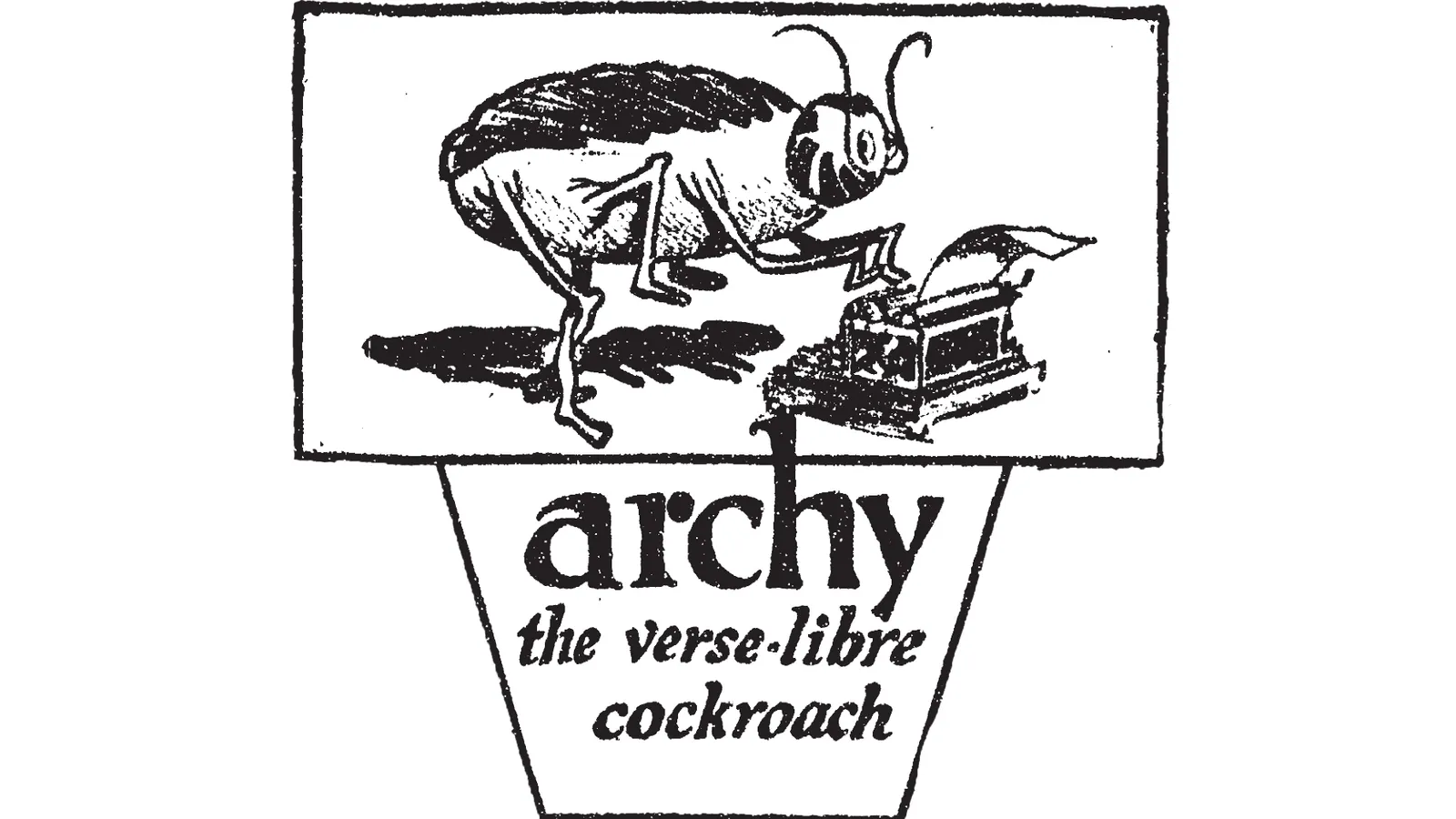
Archy the cockroach, the creation of humourist Don Marquis in 1916 (Credit: New York Tribune)
No one taught this lesson better than Archy the cockroach, a typewriter-bashing character invented by American humourist Don Marquis in 1916. Writing unpunctuated lowercase doggerel (as cockroaches cannot hold down "shift" and reach other keys), Archy would supposedly "commandeer" the New York newspaper columns of Marquis. There, he would probe lofty themes from his position of lowly stature.
One of Archy's most memorable poems featured Warty Bliggens, a toad who believes the Universe exists "to grow toadstools for him to sit under". Our poet advises that we do not smirk at Bliggens: similar "absurdities have only too often lodged in the crinkles of the human cerebrum".
The antiquity and wisdom of ants frequents Archy's verse, invariably as a foil for upstart humanity. In one 1922 column, Archy pictures the size difference between bug and human disappearing in light of the extra-galactic vastness then being revealed by scientists like Shapley. Compared to cosmic volumes measured in lightyears, what are humans but fleas? Archy's insect comrades take the opportunity to reprimand humanity for its delusions of grandeur. In chorus, they lampoon the "supercilious silliness" of this featherless biped, whose egocentrism is "cosmically comical" and "stellarly absurd". Our poet concludes that "men and insects are the same", both "transient flecks of starry dust that out of nothing came":
the things [man] thinks
are only things
that insects always knew
the things he does
are stunts that we
don't have to think to do
Archy gloats that, unestablished and unspecialised, humanity needs constantly to invent to survive. Where human societies depend upon convoluted technologies to farm or fly, insects – inheriting a regimen of instinct perfected across deep time – rely on more fool-proof means.
Insects, Archy insinuates, long ago solved many of civilisation's problems without ever having to reason or reflect. Beneath Archy's teasing jest, a disturbing suggestion lingers: perhaps insects have lasted so long – and in a manner more stable and sustainable than humans appear able to muster – precisely because they aren't encumbered with "thought".
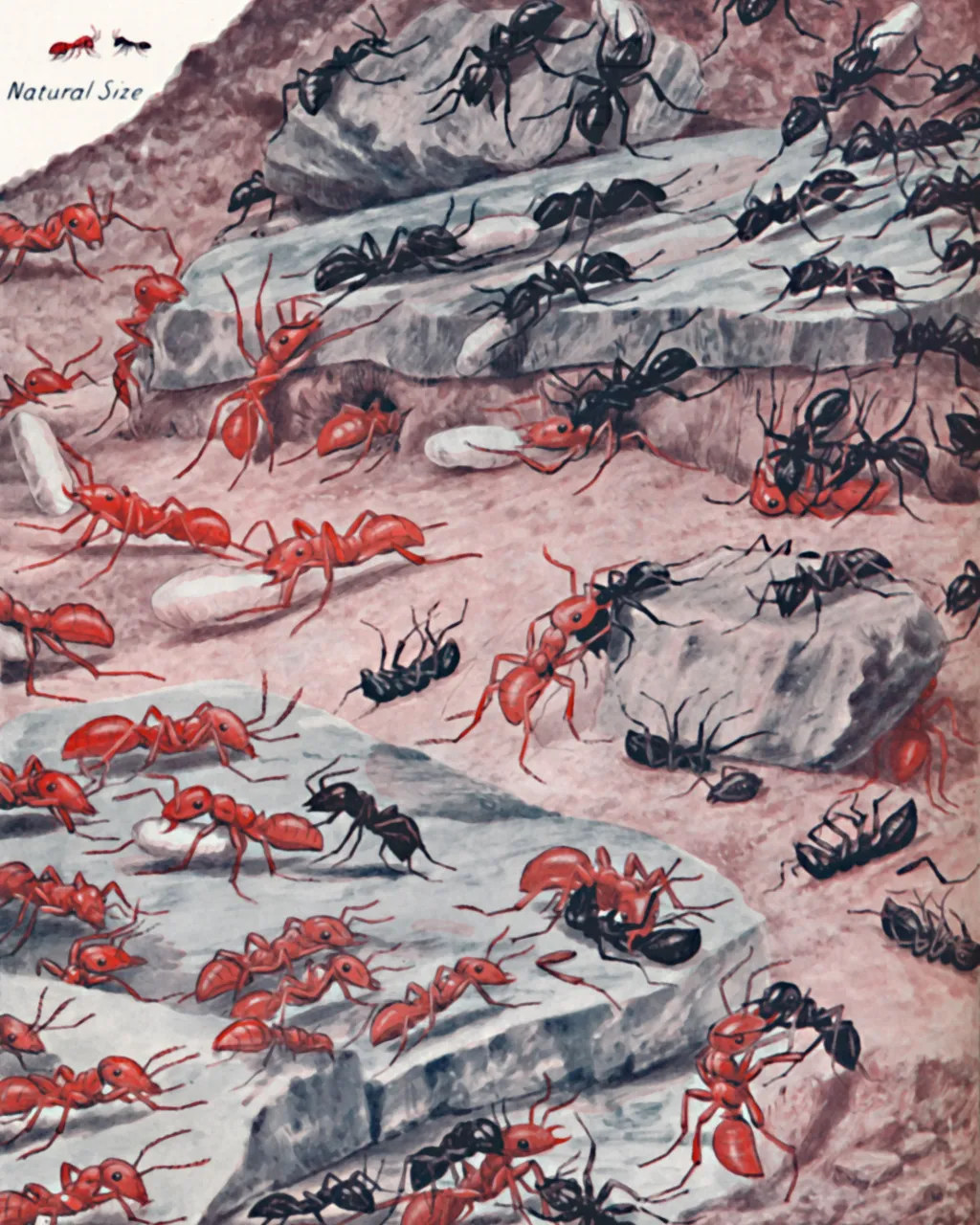
Two organised societies of ants attack one another (Credit: Getty Images)
Relying on tried-and-tested instincts, honed over epochs, insect societies had proven their staying power. By comparison, humanity has only just embarked upon large-scale cooperation.
Rather than relying upon the plodding trial-and-error of natural selection, human society rudders itself via the hastier muddlings of "reason": the ability to reflect, correct, and cumulate corrections across generations. Natural selection meanders in the millions of years; cumulative culture paces mere millennia. This explains why humans have accomplished so much in such a small amount of time, comparatively speaking. But perhaps it explains some of our more unsustainable traits, too.
Reflecting on the ant's antique wisdoms, while prophesying its "ample future", Shapley entertained this point in 1924. Humans, comparatively, are an inexperienced species, he wrote. "Moreover, we are hampered with brains. We have mentality to burn, and many do burn it, at both ends." Shapley worried our "abnormal mentalities" (particularly, our predilection for technological invention) might soon get the best of us. Then the Earth's future will be inherited by the "conservative cockroach", nesting within the "fossilised skull" of some "extinct primate".
Other scientists echoed the message during the 1920s. In World War One's wake, some implored that we become more cooperative, like the ant: any creature which begins building megapolises and meddling with atoms, without overcoming belligerence, cannot survive.
Such sermons may have then seemed idle. Indeed, in 1921, Archy himself typed carefreely about "the mighty atom that splits a planet asunder". But, 24 years later, the first atomic bombs detonated, and the question of cooperation – at global scale – became existential.
When the US began atomic testing at Bikini Island in 1946, boats loaded with livestock were readied for exposure to the blasts, to study the effects of radiation. A few months beforehand, The New Yorker suggested "one more passenger" be included alongside the farmyard animals: good old Archy. The reporter was E B White (later author of Charlotte's Web). By this time Archy was retired, because his creator had died, but White announced that "Archy's writings are pertinent today, as the cosmos slithers drunkenly into its Bikini Lagoon phase". Why? Because Archy's pedigree goes back "one hundred million years", and will probably be "good for another hundred million", because "the cockroach is the creature most likely to survive the atomic age". White referenced a 1944 magazine article, titled "Superbug", which had extolled the roach as "indestructible".
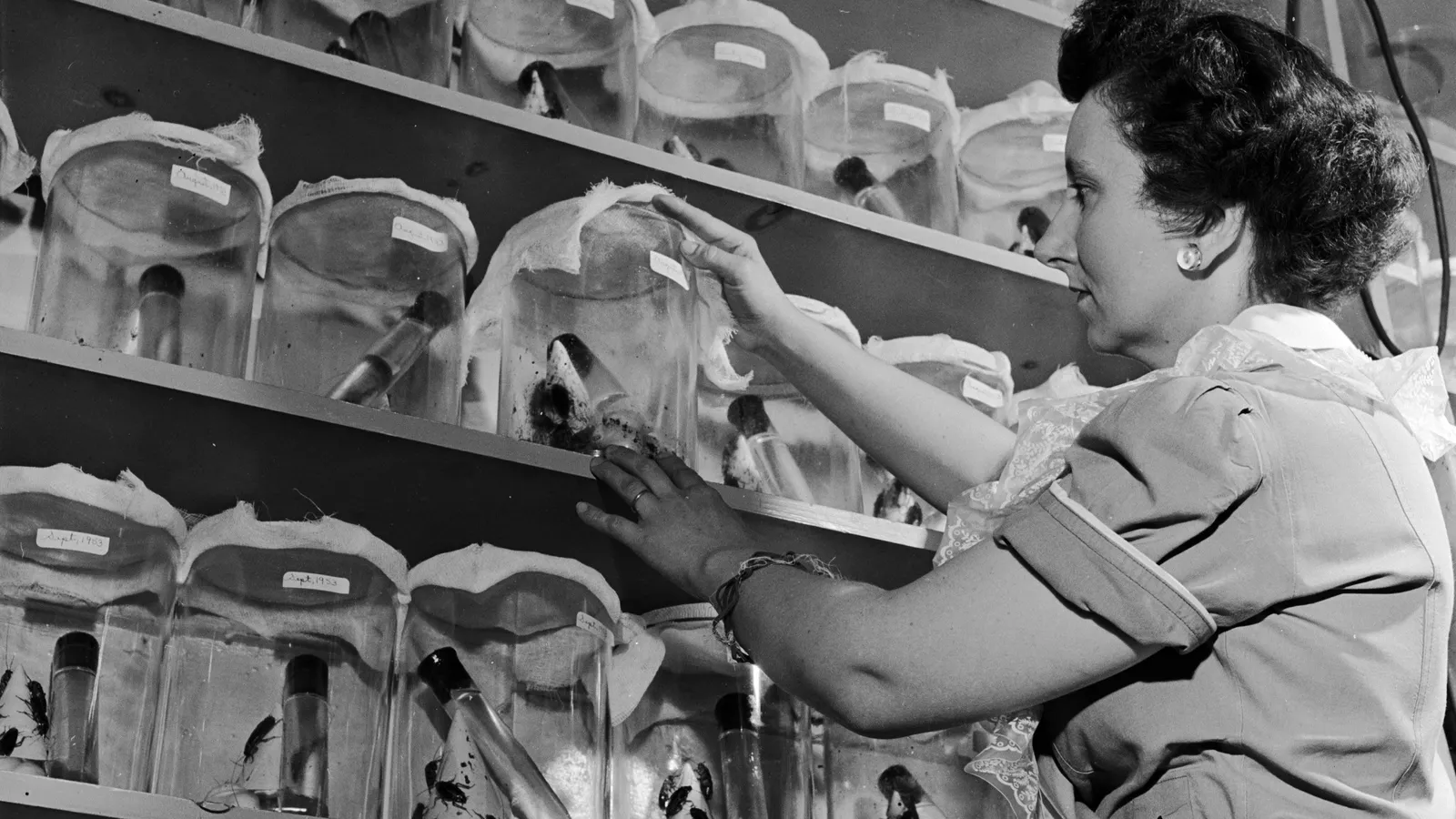
In the post-war period, cockroaches were associated with extraordinary resilience and longevity (Credit: Getty Images)
So it was that a potent Cold War motif had been born – inspired by Archy. For decades after, many forewarned the cockroach would be the only "winner of World War Three".
One pacificist pamphlet, in 1947, jested that, entering the "atomic age", we should look to the enduring roach for lessons in longevity. Either we are "wise" and educate ourselves concerning the evils of weaponising "atomic energy", or our species won't "last even as long as 10 or 20 more years", let alone the "billions" which physics had recently started forecasting as the time ahead within which Earth could remain habitable.
This is the true lesson of "orientation in time" as it flashed before Shapley at the streetcorner back in 1919. Humans have, comparatively speaking, only just appeared on Earth; but there could, potentially, be magnitudes more time ahead. The ants prove, by concrete example, that certain lineages – indeed, societies – can and do endure long-term.
Shapley returned, repeatedly, to these themes in his later works. Besides decentring Earth in space, he continued deflating human egoism by stressing that insects have, for geological durations, been practising "higher virtues" which humanity "has only recently acquired". Humans shouldn't be hasty when assuming "superiority", he intoned.
Nonetheless, Shapley acknowledged the insects are "fixed in a sociological groove with little prospect of escape". Our flexibility means we can change – and improve – our behaviours and institutions. Ants don't have histories in this way, humans do.
Moreover, Shapley acknowledged that our "enlarged frontal lobes" have granted humans a unique capacity for foresight, for taking the longer view. This means we can concern ourselves with more than our own "personal survival": we care also about the fates of people who haven't yet been born.
So, it is true that our remarkably pliant and inventive brains – "physiological oddities" that they are – may yet "erase" us "suicidally from the Earth", but it also remains true that they allow our altruism to extend further, in both time and space, than ever could an ant's.
Shapley, contemplating the antheap in Pasadena, realised that we could be at the beginning of the human story – yet within a precarious, "inexperienced" moment. Physics had just begun hinting that the future could be millions, even billions, of years long. But being so early also bequeaths the blessing of great room for manoeuvre. Being "inexperienced", our brand of brains is vulnerable and untested, but also shot through with all the plastic potentials of youth. This is how considering the ant provides "orientation in time".

Mount Wilson Observatory, where Shapley worked as an astronomer (and, outside of work, studied the ants near the telescope array) (Credit: Getty Images)
In 1921, Marquis – the creator of Archy – wrote a short piece imagining what Martians, peering down their telescopes, might make of us humans as we flitter flutter on Earth's surface. No doubt they would imagine us angels or demons, seeing only themselves in us, only their most exaggerated reflections. They would romanticise us, as we routinely romanticise other animals here on Earth.
Assuming a detached Martian-eye-view, Marquis then pondered how it is that cities come to be. Skylines are beautiful, but did any of the individual builders labour with this final beauty in view? No: it is autonomous, unconscious, almost like the termite's nest; spontaneous product of nature, almost; wrought by "no conscious thought".
Marquis noted that we are often only encouraged by humanity when we look from such "distance". Here, we see only the "lights on the high spots", and none of our private failings, bigotries, or tribal prejudices. But, he concluded, we should never forget that these "low spots" and "high spots" are made of the "same stuff". That is, though individuals invariably have little impact, and often are selfish or stupid, individual actions snowball into civilisations, and multigenerational projects, as a million happenstances weave a skyline. That's the thing with coordination; and we humans do it in time as well as space; across generations, rather than within one.
It's hard to get an outside view on the human mind, but one thing seems true. In terms of civilisation, compared to our arthropod peers, humanity remains young. Precocious, precarious, often shockingly pernicious, but brim-full of potential. Grave perils cloud our horizon, demanding immediate and urgent solutions; but protecting the present is building a shared future. Probably uniquely, we humans acknowledge this. If we live up to this quiddity then, one day, we might be near the beginning of a saga extending deep into the future — just like Archy's illustrious ancestors.
There's lots to learn from the bugs. But the deeper point is this: the history teaches that we shouldn't be chauvinists when it comes to the workings of the mind. We should be magnanimous. Agency is most certainly not everywhere, but in an era when scientists study memory in slime moulds and machine learning produces curious and unpredicted results, it would be hasty to assume our brand of braininess comes anywhere close to exhausting all that a "mind" possibly can be. But, as the minibeasts discovered ages ago, it is better to be part of a diverse crowd, in a broad church of beings.
Source: https://www.bbc.com/future/article/...ivilisations-recast-our-place-in-the-universe
Dedicated to @Disquiet


